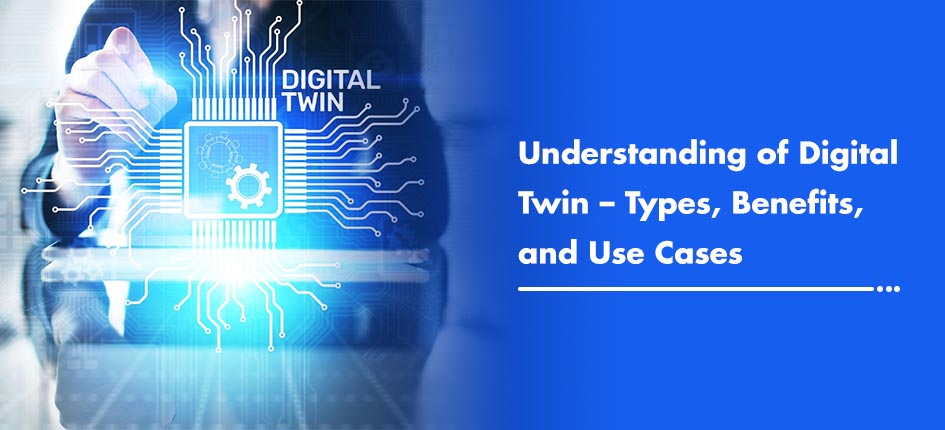Understanding of Digital Twin – Types, Benefits, and Use Cases

Though the concept of a digital twin has been around since 2002, the technology gained recognition following the rapid rise of the IoT. Besides IoT, digital twins now integrate machine learning (ML) and artificial intelligence (AI) to bring data, algorithms, and context together. So, businesses have started adopting this technology to test new ideas, detect issues before they occur, and monitor items remotely.
To understand the potential of the digital twin, you should know what it exactly is, its types, benefits, and a few use cases. Without these insights, you might struggle to get the most of your IoT investments. We recommend you to approach an IoT development company to know how you can leverage digital twin in your IoT project.
What is a Digital Twin?
A digital twin is a virtual replica of physical assets, processes, systems, and devices that can be utilized for various purposes. Simply put, a digital twin is the ability to take the virtual representation of both the elements and the dynamics of how an IoT device operates or works. It acts as a bridge between the digital and physical worlds by using sensors to gather real-time data of a physical asset. Subsequently, the data is utilized to create a virtual replica of the asset, enabling it to be understood, analyzed, or optimized easily. Other terms used to describe digital twin over the last years are hybrid twin, virtual twin, virtual prototyping, and digital asset management.
Types of Digital Twin
Depending on what they replicate virtually, digital twins can be classified into three types:
Discrete Digital Twins are used to analyze and optimize individual assets, people, and other physical resources.
Composite Digital Twins, on the contrary, is a virtual replica of composite material used for manufacturing purposes. Mostly, the composite material is used in a variety of industries like aerospace, architectures, and energy.
Digital Twins of Organizations (DTOs) maximize the value across specific processes like manufacturing or entire business operations.
Benefits of Digital Twins
Earlier, digital twins were used to improve the performance of a single asset like a wind turbine or a jet engine. However, the technology has become quite sophisticated lately. Now, it connects systems of assets or even entire organizations and transforms their operations significantly. Let’s dive in to unleash how digital twin can benefit your business.
Reduces Issues Related to Product Quality – Digital twins help you understand the possible outcomes, improve operations, and quickly detect product quality issues.
Lowers Maintenance Costs – Digital twins predict maintenance failures through simulation models that store information about various operating scenarios, risk factors, and system configurations. Thus, you can reduce downtime, enhance equipment reliability, extend their life span, and save huge costs.
Improves Productivity – Using digital twins, you don’t have to experiment with physical objects or halt ongoing processes to improve overall operations. All you have to do is run simulations in the lab to understand the risks as well as the benefits of new processes and keep refining them to obtain the best results.
Facilitates Employee Training – Digital twins can create virtual real-life situations to train employees. You can also teach them how to handle equipment that is too costly to be given hands-on training.
Use Cases of Digital Twin
The benefits of digital twins are enormous. Now, let’s have a look at some of its uses cases.
Automobile – Digital replicas of automobiles gather behavioral and operational data of their physical counterparts to monitor and improve their performance. They also help in developing and testing new products like hybrid and electric vehicles.
Construction – Digital models of building capture real-time data about their infrastructure using sensors and other wireless technologies. They not only help in improving the design and quality of construction projects but also reduce maintenance costs.
Sports – Sensors and analytics help in creating digital replicas of players and simulate game situations to detect most likely injuries and improve performance. F1 racing teams utilize digital twins to monitor adjustments and enhance the performance of their cars.
Healthcare – The virtual replica of a patient or an organ enables physicians to practice procedures in a simulated environment. This technology is also used to conduct digital clinical trials before releasing new drugs or vaccines.
Aerospace and Defense – The National Aeronautics and Space Administration (NASA) utilizes digital twins to operate, maintain, and repair systems in the outer world. Similarly, the US military uses the technology to validate the integrity of the chips and semiconductors used in their weaponry.
Final Words
For businesses that already use IoT, the digital twin is the next step to steer their digital journey toward the right path. If you’re planning to optimize processes, improve efficiencies, and achieve better business outcomes, digital twins are worth embracing. For more information about the technology and how you can integrate it into your business operations, approach the experts of our IoT development company.

